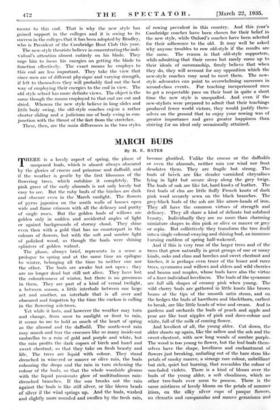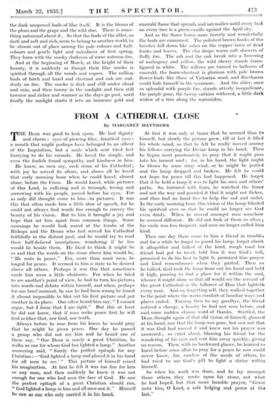MARCH BUDS
By H. E. BATES
THERE is a lovely aspect of spring, the phase of unopened buds, which is almost always obscured by the glories of crocus and primrose and daffodil, and if the weather is gentle by the first blossoms of the flowering trees, which outshine it completely. The pink grace of the early almonds is not only lovely but easy to see. But the ruby buds of the birches are dark and obscure even in the March sunlight. The flowers of pyrus japonica on the south walls of houses open wide and flame crimson with all the delicacy and purity of single roses. But the golden buds of willows are golden only in sudden and accidental angles of light or against backgrounds of stormy cloud. They shine even then with a gold that has no counterpart in the colours of flowers, but with the soft and sombre light of polished wood, as though the buds were shining splinters of golden walnut.
The phase, always brief, represents in a sense a prologue to spring and at the same time an epilogue to winter, belonging all the time to neither one nor the other. The buds are awake but not open ; they are no longer dead but still not alive. They have lost the colourlessness of winter, but there is no greenness in them. They are part of a kind of vernal twilight, a between season, a little interlude between one large act and another, an interlude that is all over and obscured and forgotten by the time the cuckoo is calling in the flowering ash-trees.
Yet while it lasts, and however the weather may turn and change, from snow to sunlight or frost to rain, it seems to me to hold as much of the heart of spring as the almond and the daffodil. The south-west rain may smash and tear the crocuses like so many inside-out umbrellas to a ruin of gold and purple and white, but the rain profits the dark copses of birch and hazel and sweet chestnut, so that they take on fresh beauty and life. The trees are liquid with colour. They stand drenched in wine-red or mauve or olive rain, the buds colouring the drops and the rain in turn richening the colour of the buds, so that the whole woodside gleams with the liquid passionate glow of multitudinous rain- drenched branches. If the sun breaks out the rain against the buds is like still silver, or like blown beads of silver if the wind springs up. And the buds, washed and slightly more rounded and swollen by the fresh rain, become glorified. Unlike the crocus or the daffodils or even the almonds, neither rain nor -wind nor frost desolates them. They are fragile but strong. The buds of beech are like slender varnished chrysalises lying in light but secure sleep along the grey twigs. The buds of oak are like fat, hard knots of leather. The first buds of elm are little fluffy French knots of dark pink wool securely sewn on the black branches. The grey-black buds of the ash are like arrow-heads of iron. They all have the common virtues of strength and delicacy. They all share a kind of delicate but subdued beauty. Individually they are no more than charming miniature shapes in dim pink or olive or mauve or grey or sepia. But collectively they transform the tree itself into a single colossal swaying and shining bud, an immense turning emblem of spring half-wakened.
And if this is very true of the larger trees and of the trees that grow naturally in great groups of one or many kinds, oaks and elms and beeches and sweet chestnut and birches, it is perhaps even truer of the lesser and rarer trees, sycamores and willows and alders and wild cherries and beams and maples, whose buds have also the virtue of a finer individual loveliness. The buds of the sycamore are full silk shapes of creamy pink when young. The wild cherry buds are gathered in little knots like brown beans at the tips of the smooth satin stems, and on the hedges the buds of hawthorn and blackthorn, earliest to break, are like little beads of wine and cream. And in gardens and orchards the buds of peach and apple and pear are like taut nipples of pink and dove-colour and white, full of the milk of coming flower.
And loveliest of all, the young alder. Cut down, the alder shoots up again, like the sallow and the ash and the sweet-chestnut, with new long wands of sombre purple. The wood is too young to flower, but the leaf-buds them- selves have the shape, loveliness and enchantment of flowers just breaking, unfurling out of the bare stem like petals, of smoky mauve, a strange rare colour, unbrilliant but rich, quiet but burning, that resembles the colour of sun-faded violets. There is a kind of bloom over the buds of the young alder, a soft cloudiness, which no other tree-buds ever seem to possess. There is the same mistiness of lovely bloom on the petals of summer irises, on the silky silver cups of pasque flowers, on clematis and campanulas and mauve geraniums and the dark unopened buds of lilac itself. It is the bloom of the plum and the grape and the wild sloe. There is some- thing autumnal about it. So that the buds of the alder, so dark and soft and rich, seem to belong to another world, to be almost out of place among the pale colours and half- colours and gentle light and nakedness of first spring. They burn with the smoky darkness of some autumn fire.
And at the beginning of March, at the height of their beauty, it is suddenly as though their lilac smoke is spirited through all the woods and copses. The million buds of birch and hazel and chestnut and oak are sud- denly on fire. The smoke is dark and still under cloud and rain, and then tawny in the sunlight and then still tawnier and richer and warmer as the days go past, until finally the sunlight starts it into an immense gold and emerald flame that spreads and intensifies until every bud on every tree is a green candle against the April sky.
And as the flame burns more fiercely and wonderfully the buds are consumed. The polished brown husks of the beeches fall down like ashes on the copper lawn of dead husks and leaves. The elm drops warm soft showers of fluffy fire. The ash and the oak break into a flowering of mahogany and yellow, the wild cherry stands trans- figured in white. The willows are turned to balloons of emerald, the horse-chestnut is glorious with pale brown flower-buds like those of Victorian wool, and Zacchaeus could hide himself in the sycamore. And the alder, once So splendid with purple fire, stands utterly insignificant, the purple gone, the tawny catkins withered, a little dark widow of a tree along the watersides.





























































 Previous page
Previous page